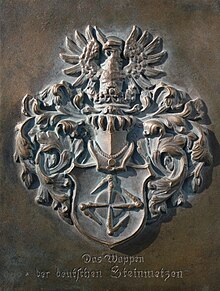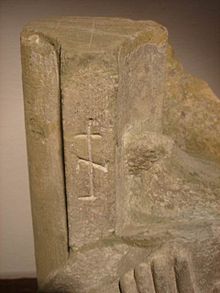Steinmetzordnung
The stonemason regulations reflect a special historical form of organization of the handicraft in the Middle Ages , which was significant for Gothic construction from the 13th to the 16th century and is unique. The stonemason orders played a major role in Gothic cathedral construction. With the development of the building industry in the 12th century and the emergence of numerous cities, the requirements for building construction and building organization developed. The regulations existed for centuries through oral tradition and were not written down until the end of the 14th century.
Such rules and regulations as the stonemasonry regulations did not exist in any other medieval craft . These regulations not only laid down professional processes, but the stonemasons of the construction works had their own jurisdiction, their own rules about their customs, meetings and associations. There were rules that determined not only the professional processes, but also the relationship between those involved, the masters , journeymen and apprentices .
The most important stonemason order was the so-called Strasbourg stonemason order of April 24, 1459, which was updated on September 29, 1533 in the "Brother's Book". In addition, there were stonemason regulations of regional construction huts, which were based on the above-mentioned regulations.
Formation
The stonemason orders remained unwritten at first, were only passed on orally within the metallurgy and, towards the end of the construction metallurgy, were written down in detailed regulations. In contrast to the German development, there was already a record in England in 1390, in the so-called Regius Manuscript.
In the course of the 13th century, the construction works came up in Central Europe. The Bauhütten developed a specific organizational structure based on division of labor, which should meet the high technical and craft requirements of the Gothic cathedral construction. The construction huts initially united only stonemasons who organized themselves in so-called stonemason brotherhoods .
In 1275 Erwin von Steinbach (1244-1318) convened a meeting of the most important German, French, Italian and English builders' huts. This is considered to be the decisive step in the development of the building industry. Steinbach, master builder of the cathedral of Strasbourg, intended to standardize the existing rules in order to make the work easier and more fair. At the same time, the Münsterbauhütte was recognized by Strasbourg as the highest main hut, as the highest and last instance. There were also the main huts in Cologne, Bern (later Zurich) and Vienna. In this context, it is assumed that the Roman-German King Rudolf I , a Habsburg , enfeoffed the construction works with free jurisdiction.
Content
The main contents of the stonemason regulations of Strasbourg and the brother book are named below:
The level of wages paid on the day a journeyman entered the building was regulated. The apprenticeship training period was fixed. There were regulations for disputes between workers in the building works. The final highest judgment in appeals against judgments was made by the top construction works, the main construction works of Strasbourg. This was later changed and the final judgment attributed to the emperor, which was never practiced.
There were exemplary penalties. The punishment was also possible, the so-called slapping with long wooden slats on the buttocks of the convicted person .
The ordinances had numerous references to formulas of vows to be taken, such as oath, obedience, vows, and fidelity. For example, when joining the brotherhood, a vow had to be made.
Should the master die, a suitable journeyman could continue the work. Two masters could only work on a small building that had to be completed within a year. The master had to adhere exactly to the given construction plan. If a master had an illegitimate relationship, no journeymen or journeyman were allowed to work for him. The masters had to read the rules once a year and all foremen, journeymen and journeymen had to obey it. The smelter had to keep the cash box, called a rifle, into which each journeyman had to pay a penny a day in order to provide financial support for journeymen who were sick or who were involved in legal proceedings.
Apprentices had to pay an apprenticeship fee and they were not allowed to be under 14 years old when they started their training. In the later regulations, a training contract had to be concluded in writing (a slip of paper). The trial period for an apprentice could not last longer than 14 days. A trained mason who wanted to become a stonemason had to complete a three-year training course as a stonemason.
The exercise of the profession could be prohibited and dismissals could also be issued. Later, a journeyman could not be financially recourse for a termination. Bricklayers could be used to roughly process the stone .
The stonemason's mark becomes a mark of honor in the later regulations.
written form
It is generally recognized that the building works regulations of April 25, 1449 apply as the written set of rules for the oral transmission of the building works regulations. The four representatives of the main smelters (Strasbourg, Cologne, Vienna, Bern) were invited to a consultation in Strasbourg in 1445 by the cathedral builder Jost Dotzinger . No final agreement was reached there. This only succeeded after further meetings in Speyer, Strasbourg and finally in Speyer in April 1449, where all construction works of the then German Empire and Switzerland came to an agreement, which is recognized as the Strasbourg stonemason ordinance.
Why it came so late to a written regulation of the building industry is explained with different. Above all, the relative independence of the Gothic construction huts is mentioned, a developed memory culture of medieval craftsmen, the wandering of journeymen, many of whom could not read, the secrecy of the rituals and the structural and planning principles of stone carving.
validity
The stonemason order was presumably already in 1459 by Emperor Friedrich III. confirmed . What is certain is that it was signed by the Rex Romanorum Maximilian I on October 3, 1498 and by Emperor Ferdinand II in 1621.
Around 1500, with the beginning of the end of the Gothic period, numerous cathedral huts were dissolved and, on the other hand, stonemasons outside the builders' huts merged into guilds . Some of the construction huts merged with the city guilds. The Reformation initiated by Martin Luther also had consequences for the construction huts. T. sank to the point of insignificance. In 1509, the Cologne building works, which only revived in 1840.
Downfall
In the course of this historical process there was a reaction and adjustment of the Strasbourg stonemason order in the so-called brother book in 1563. In the brother book, the Strasbourg order was further laid down and supplemented with regulations that can be explained with the religious upheavals of the 16th century. The following construction huts had the same hut regulations in the brother book to which Strasbourg “should be subject: Speyer, Zurich [main hut], Augsburg, Frankfurt, Ulm, Heilbronn, Blaffenburg (Pleffenberg?), Dresden, Nuremberg, Salzburg [main hut], Mainz, Stuttgart, Heidelberg , Freiburg, Basel [main hut], Hagenau, Schlettstadt, Regensburg, Meisenheim, Munich, Ansbach and Constance. “Vienna, Magdeburg and Meißen are not mentioned. Numerous controversial points were adjusted in the brother's book, which ultimately could not stop the end of the validity of the stonemasonry regulations and the demise of the building industry.
When Strasbourg became French in 1697, the Regensburg Reichstag on May 16, 1707 and again on May 13, 1727 forbade all connections between German construction works and Strasbourg. On August 16, 1731, Emperor Karl IV. Forbade the construction works their own jurisdiction, customs, meetings and associations without imperial approval and finally, on April 30, 1772 , Emperor Josef II obtained the strict execution of the aforementioned regulations in the so-called Commission edict. This ended the legal existence of the construction huts.
literature
- Alfred Schottner: The "regulations" of the medieval cathedral huts. Writing and updating of the orally handed down rules of the stonemasons. Lit Verlag, Münster 1994, ISBN 3-8258-2353-9 .
Individual evidence
- ↑ Alfred Schottner: orders. P. 1 (see literature)
- ↑ Alfred Schottner: orders. P. 70
- ↑ Alfred Schottner: orders. P. 3
- ↑ The stonemason ordinance of 1459 and the stonemason ordinance of 1563. In Schottner: order. Annex I and III.
- ↑ Alfred Schottner: orders. P. 15/17.
- ↑ Alfred Schottner: orders. P. 24
- ↑ Alfred Schottner: orders. P. 77
- ↑ Franz Ržiha: Studies on the stone carving marks . Reprint of the original edition from 1883. Zentralantiquariat der DDR, Leipzig 1989, ISBN 3-7463-0163-7 , p. 15.
- ↑ Alfred Schottner: orders. Pp. 2-4


